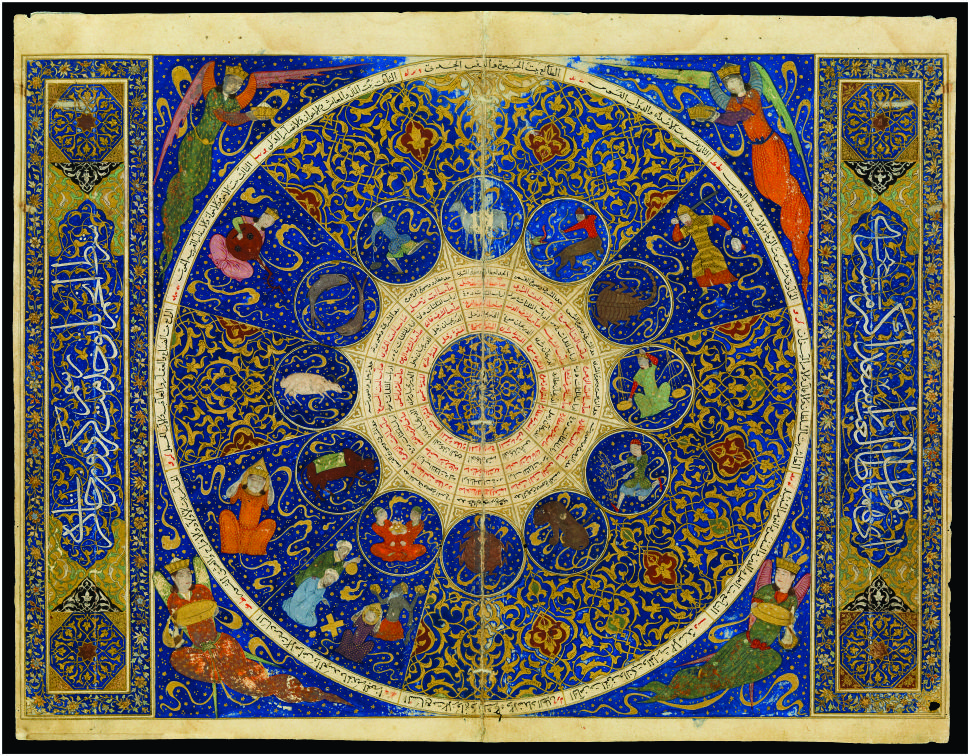
by
Michael S. Schneider
M.Ed. Mathematics

Wellcome Collection
The Iskandar ("Alexander") Sultan lived a brief but interesting life.
From his Wikipedia entry: "Iskandar Mirza (1384 – 1415) was a member of the Timurid dynasty and the grandson of its founder, the Central Asian conqueror Timur. Iskandar was among the princes who attempted to claim the throne in the aftermath of Timur's death. He became a prominent ruler and was notable for his strong interest in culture and learning. He was defeated by his uncle Shah Rukh and later executed during a rebellion attempt." I wonder if that was in his horoscope.
This horoscope was made for him in 1411 when he was 27, three years before his demise.
Because it's an astrological horoscope from that place and time it naturally has a 12-fold structure.
It's found in the Wellcome Collection (click to see picture details) in London, near the British Museum, and appears in an exhibit at the Victoria & Albert Museum (May 2021 -).
Sacred art around the world in virtually every culture was, by tradition, designed using strict geometric principles because geometry was considered a divine language, appropriate for such art.
To understand the geometry by which this horoscope painting was composed, let's first consider its overall dimensions (not the dimensions of the paper).
I've drawn a green rectangle around the painting. The ratio of its dimensions, its width/height, seem to be about 1.38 to 1.

This value can be visualized geometrically as a large square flanked on the right side by a rectangular column composed of a small square atop a vertical Golden Rectangle.
The ratio (width/height) of the vertical right column is 1/phi^2 (= 0.3819...).
So the overall dimensions of the painting are 1.381... to 1, or in terms of the Golden Ratio, a simple (phi^2 + 1) / phi^2.

I've quartered the small square and Golden Rectangle, producing two identical columns:

The quarters are simply rearranged:

Next, the left column is shifted to the left of the large square. This shows us a large central square flanked by two vertical columns.
Notice how well the side columns define the lines of the painting, and the division of the blue rectangle within each:

The four corner Golden Rectangles have been quartered to reveal more detail of the composition:

Finally, Golden Rectangles have been placed in the centre of the double squares to show how the width of the blue rectangles was determined.
Flanking each Golden Rectangle are miniature models of the larger side columns alongside the large square.
The remaining frame edge area above and below it can be filled in with similar squares and Golden Rectangles.

Now, to understand the geometry which structures the central, circular horoscope, twelve equally-spaced points are found around the red circle, and every fifth point is connected to produce this dodecagram star:

I've erased lines which are not used in the centre:

Twelve identical circles are drawn, each centred within an arm of the star. Notice that the circles are tangent to each other, with no space between them.

The uppermost point of each circle is identified and connected to produce a miniature version of the larger star.
Notice how the lines cross to define the intended size of the blue and gold circle at the centre.
Like all great "sacred geometers" of old, the designers of this horoscope let the geometry show them how to proportion the imagery.

Finally, we put it all together by combining the construction of the rectangular painting with that of the central, circular horoscope:

The design of the circular horoscope reminds me of the 12-fold geometry underlying the design of the North Rose Window of Chartres Cathedral, from two centuries earllier, which can be seen here.
They are nearly identical but there are some slight yet important differences between their rings of twelve circles.
“To harmonize the whole is the task of art.”
-- Wassily Kandinsky (Concerning the Spiritual in Art)
Constructing The Universe home page
© Michael S. Schneider 2021